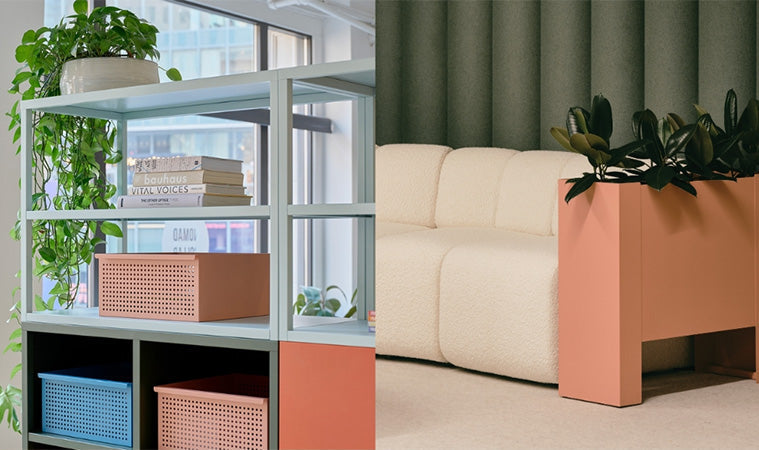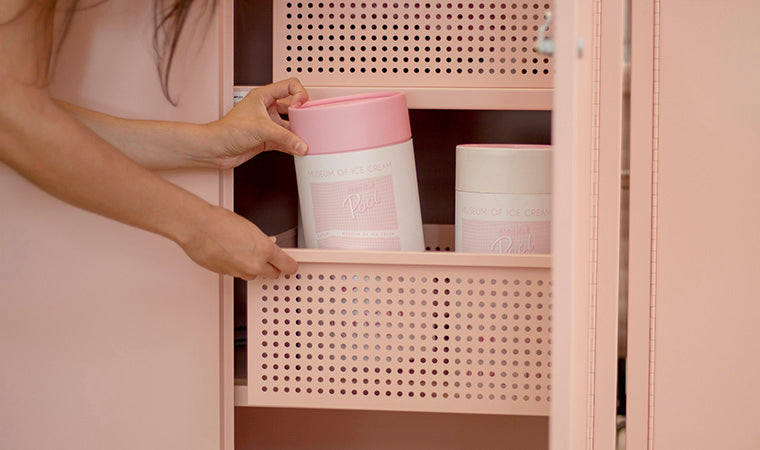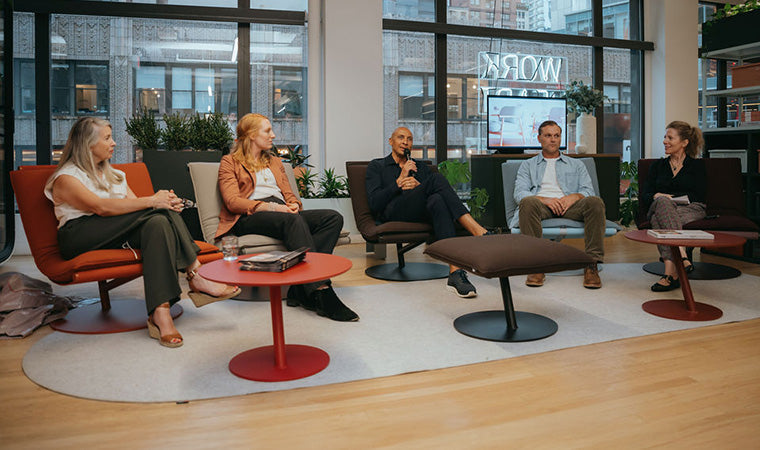One thing Fully and Heartwork have in common is the appreciation for beautiful, quality furniture for healthy work-from-home and office furniture solutions. So when Fully, an e-commerce leader for great work design solutions, was in the process of planning their new office space in Portland, OR, to support their exciting expansion, they turned to Heartwork. “Ultimately, we not only wanted to create a space for people to get out of their house during the day, but also a place of refuge and familiarity that we had missed while being remote 100% of the time. The office space also needed to work for the new normal of hybrid working,” explains Sarah Gray, Fully’s Workspace Designer. Fully’s goal was not to simply return the office space to its original state, but to create a place that fulfilled their new vision for hybrid work.

When designing the new Fully space, what were your goals for the project?
Our main goal was to have a place to come together again after being apart for such a long time. We experienced a lot of growth during the pandemic and our old office wasn’t quite large enough to accommodate everyone, so we knew the search was on. In addition to needing more space, we also needed one that was more conducive to the hybrid working conditions we knew would be around for the times to come. The ability to collaborate was incredibly important, but areas where people felt they were able to do focused work when needed, were also required – spaces where people can work separately but together. We had to rethink what the office meant and how it fits into the new workplace experience we wanted to foster with more intention around how people will use the space going forward.
Where did you find your inspiration and what did your design process look like?
The first thing we did was conduct a survey to figure out where people were at in regard to hybrid work– what was working and what wasn’t? How could we make the office bridge that gap for as many people as possible? What things were essential and what was nice to have? What was everyone looking forward to about having an office to come back to again? Ultimately, we wanted to create a space not only for people to get out of their house during the day but also a place of refuge and familiarity that we had missed while being remote 100% of the time. The office space also needed to work for the new normal of hybrid working – physical and digital collaboration – whether that’s a large brainstorming group or an intimate one-on-one conversation. Inspiration came from trends we found in our own work creating office spaces for companies going through the same things we were. We know hybrid work works and people want to stay remote at least part of the time. What spaces can’t be recreated at home? What tasks were more effectively done in the office? How could we create a space that enticed people to come back for those moments of collaboration and shared experiences?
In designing for your hybrid return to work, what were some of the challenges you had to solve?
We had to make sure the office worked for the collective whole. A major component was that the conference rooms had to function well for those physically present in terms of comfort and usability, but they also had to work effectively for those who are remote. This was a big task for our IT department. Outside of making sure the spaces functioned well for those present either physically or digitally, we also really needed to consider how to make sure that people wanted to be in the office. After being at home and in their own personal spaces for 2 years, it was definitely a challenge to figure out how to entice people back, even part-time. Noise levels, visual distractions, and personal comfort factors all play a greater role in the office space than they have in prior times. We had to really consider natural light, materials for sound absorption, and make sure there were plenty of private corners where people could hide away if they needed a personal moment or some time to focus and get something done. I think the large communal breakroom and adjoining pit gathering space certainly help to foster that sense of community we were all missing as well. I don’t know if it was necessarily surprising, but we should never underestimate the value and effectiveness of free food and a good conversation with a colleague/ friend you haven’t seen in a while halfway through the day.

How are you and your team thinking about your workspace differently?
While Fully has always been tuned-in to work-life balance and flexible working habits for its employees, full remote working was not something that was standard. Looking post-pandemic, we now have fully remote employees, hybrid employees, and some people who want to work out of an office more often. The office space however needs to work for everyone – not only as a place to come together physically but also digitally. We want to continue to let people make the choice that is best for them, their lifestyle, and their own situation. Conference rooms (both formal and informal) are prioritized to a greater extent in our current office space than in the previous one because now in-person meetings hold so much more meaning than before. The break room and “pit” gathering space are larger because when people are in the office, they want to be together that much more. These spaces are now seen more as destinations and attractions instead of just somewhere to eat or have a meeting while you’re at work for the day.
How did you think about supporting individual and team storage needs within a shared workplace?
Most teams have a designated area where if they need to store something, they have the allotted space – even though it’s not necessarily required they sit in that area. Aside from a few rooms dedicated to specific teams, the whole floor is an unassigned workspace. Our accounting and HR departments have storage and our product development team has their own space with ample storage for their needs. We also had enclosed storage sprinkled around the office space that we were able to allot to different departments on an as-need basis like our marketing teams, systems/IT, and showroom personnel. Personal storage was handled a bit differently in the form of the unassigned personal lockers. Someone can use a locker for as little as an hour or for the full day – however long they need it (similar to the open unassigned desking). It’s a secure place to leave their belongings while they move around the office as their individual needs and schedule dictate during the day.
How are the Heartwork Base Camp 15W modular lockers being used by employees?
Since we are implementing a hybrid work approach, most people seem to come into the office for specific meetings and on certain days of the week. Some are more regular, and some have more variability. Some stay for the full day, but many come and go as their workload shifts and focus work takes them home again. All of our desks are unassigned with no personal storage. Having the lockers makes it easy for someone to come into the office and remain exceptionally flexible while they’re there during the day. They can work at a desk to get some focus time in before moving into a meeting room or collaborating in an open lounge setting later in the day. They don’t have to worry about the security of their belongings at any point during the day. The lockers also allow our employees who choose to ride their bikes to the office a place to store their belongings. Our building provides shower access, but personal storage is a necessity for that. We ultimately felt that personal storage space in an office that is designed for unassigned collaboration is key to making sure the office space gets used effectively.
What have you and your team missed the most while working remotely?
I think the feeling that you’re part of a greater whole and not out there on your own is a big one. Fully has always thrived on the sense of community and togetherness. While being physically together definitely isn’t the only way to effectively communicate these values, it certainly helps and it took some time to figure out how to keep that mentality going while we all had to be fully remote. Fully lunches, happy hours, and random meetups – especially during the warm summer months – are something we took for granted pre-pandemic and I think everyone is looking forward to them starting up again.
What made you think of Heartwork for this project?
We knew we needed some personal storage space for our employees who would be coming into the office. Many people bike or arrive on foot and need a spot to store their helmets or change of clothes. Additionally, since all of the desking in the new office space is unassigned, we didn’t want to have any of the storage be at the desk and we needed to make accessible and easy to get to during the day by everyone. It also had to be secure and lockable. The Base Camp 15W Locker was perfect for this since it came in different sizes that we could tailor to our specific needs. The user-friendly locking mechanism makes it easy for people to grab a locker, use it for however long they need it during the day, and then return the key making the locker available again. The minimal aesthetic and bright color choices with the Active Duty Recycling Credenza made for a great design moment as well!
What are the new solutions you find workplaces are requesting more often?
Phone booths and flexible partitions. While offices are increasingly becoming destinations for collaborative group work, the need for focused quiet work still remains. Phone booths easily create a space for someone to make a phone call or grab some heads-down time between meetings, and they provide respite for employees who need a little quiet time when the open office gets too noisy. They don’t take up valuable collaborative space whether it’s open seating or enclosed conference rooms and they can fit in tight spaces that would otherwise go unused. Flexible partitions also help create spaces when they’re needed, but they can be moved around and adjusted as required for the type of work happening or the size of the group needing it. Ad-hoc meeting space can be configured almost instantaneously which makes the office space more useful for those spontaneous collaborative encounters.



